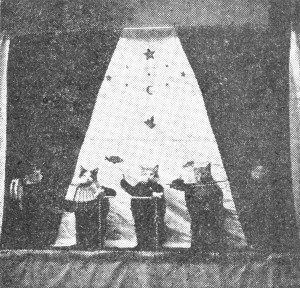A circus is only as good as its crew. Sig recognized this and treated his performers like family. His circus boasted a tremendous lineup, such as headliners William Irwin “The Most Marvelous Equilibrist that Lives” and his wife, Mademoiselle Irwin, “The Strongest Lady in the World.” Conora Berato, “The Sylph of the Floating Wire”, Sam Alix “The Wonderful Human Spider on the Swinging Perch,” and John Blendinger “The Champion Egyptian Fire Juggler” were also a part of the unit.
When Sig decided to make Homer his winter home, he provided for his employees as well. Trading his hotel in DeRuyter for the Windsor in Homer (which he would go on to humorously rename the David Harum House), the circus families integrated into day-to-day life. Children raised on the trapeze or in clown acts attended the local schools alongside children whose summer activities were far less spectacular. The strong acts and the contortionist shared the grocery store aisles and post office lines with the housewives and laborers of Homer. And by all accounts, they did so amicably.
However, the circus folk’s loyalty to Sig ran deep, and if crossed, they weren’t always quite so amicable. Such was the occasion on August 16, 1901.
A drifter, by the name of Herbert Tackaberry, had been sullying the reputation of the circus. It was reported by the Syracuse Evening Herald that “Tackaberry had been following the circus, running a gambling outfit” as it toured in Saratoga, New York. J. Charles Banks, the circus manager, had finally had enough and ran him off the previous evening. The next night, Tackaberry would not be so easily persuaded. A scuffle ensued between the two, a gun rang out, and Tackaberry was shot dead.
The coroner, upon examination, discovered Tackaberry had been shot twice. Once through the right temple, exiting through the skull. The other bullet entered below the ear, severing the jugular vein and carotid artery. Banks was arrested on the spot for murder in the first degree. Immediately he plead self-defense.
Because the witnesses were all performers in the circus, testimony would not be taken until after the conclusion of the evening show. Richard Raymond, the ticket seller, was the first to take the stand. Raymond stated that he saw Tackaberry approach Banks, with his hand on his hip. He noted that he did not hear a word spoken between the men before “an instant between the time of the scuffle and the firing of the shot.”
Raymond had been touring with the circus for three months and was well acquainted with both men. One evening, Tackaberry threatened Raymond with a revolver, saying that if Raymond spoke to Banks about him, he would “croak” him. Tackaberry promised Raymond that if he were forced to leave the circus grounds, he would get even.
Raymond testified, “Tackaberry carried two revolvers, one in his hip pocket and the other in his vest pocket, wore brass knuckles at times, and carried a cane and a lead Billy club.” Some witnesses testified that the weapon was in Tackaberry’s possession and that he “was loading it apparently for use when Banks snatched it and fired the two shots.”
Circus employees testified to Bank’s charters, calling him “an inoffensive sort of fellow.” Fifteen witnesses stepped forward to testify that Tackaberry had threatened Banks with violence on multiple occasions. In the end, the coroner exonerated Banks.
On November 15, 1901, Banks was acquitted.
Waterloo Observer published that same day, “The many friends of J. Charles Banks, of Seneca Falls, were pleased to note this morning that his trial for the murder of Herbert Tackaberry… had been finished and that the jury, after being out five hours, had returned a verdict of not guilty.”
Alas, poor Banks was left behind. For as anyone in the circus knows, the show must always go on.




